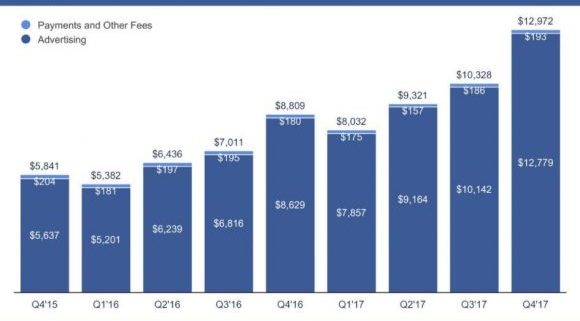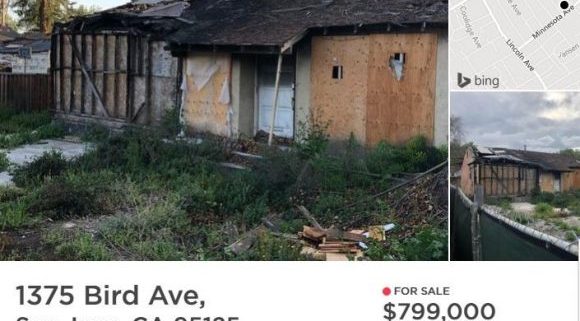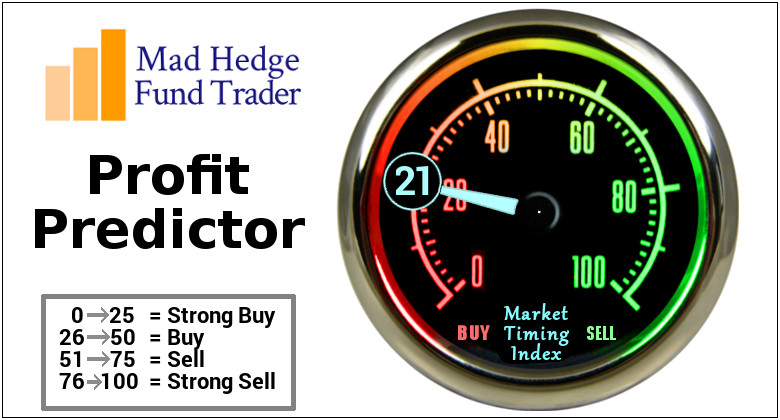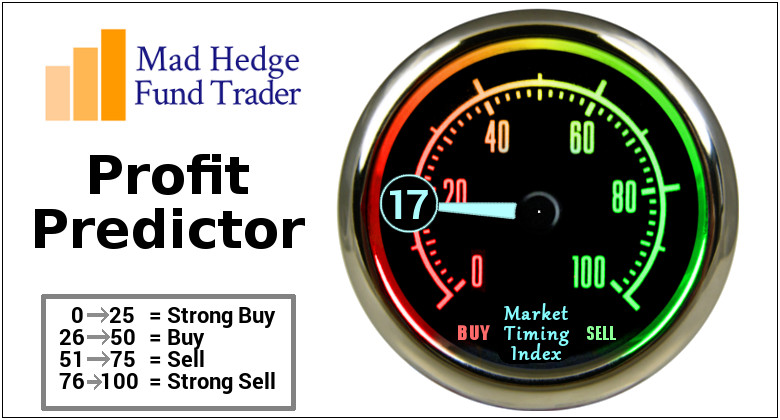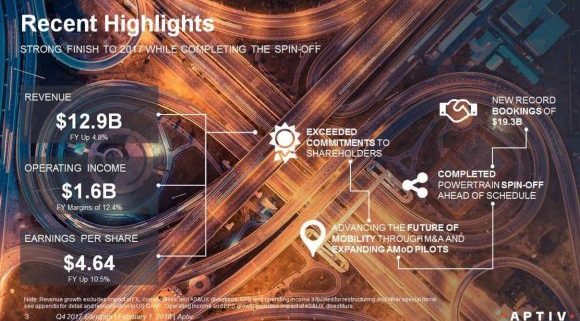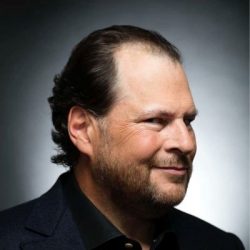Mad Hedge Technology Letter
April 18, 2018
Fiat Lux
Featured Trade:
(WHY YOU SHOULD STILL BE BUYING FACEBOOK ON THIS DIP),
(FB), (GOOGL), (AMZN), (NFLX)
He did just enough.
He did 5% enough, but it should have been 10%.
That was the performance of the highly controversial data company Facebook (FB) in the wake of Mark Zuckerberg's (the aforementioned "he") testimony in front of politicians who failed to correctly pronounce his name let alone understand his business model.
But Zuckerberg did well.
Well enough that investors approved in droves.
Facebook shares tanked after the Cambridge Analytica scandal was disclosed, and the stock traded 16% below its February high.
The FANG stocks lost more than $200 billion in market value at one point when the headlines went viral.
Amazon (AMZN) and Netflix (NFLX) accounted for more than 30% of the S&P 500's 2018 gains in February, and their contribution has dipped to about 24% as of early April.
The leadership burden for large-cap tech is a resilient pillar propping up the equity market.
Let's get this straight - there has been no regulation as of yet but this moves forward any regulation that eventually was going to happen.
However, it could be a highly diluted version of any worst-case scenarios of which one could think.
The big question: Will earnings and guidance be sideswiped because of higher data costs?
And how many of the 2.2 billion MAU (Monthly Active Users) permanently deleted their Facebook accounts?
Facebook profile removals surged to 4,000 to 5,000 the first few days after the news hit and decreased to 2,000 per day in late March. The numbers further subsided to 1,000 at the start of April.
Deletions around the political testimony were clocking in between 1,000 to 2,000 per day.
To put this into perspective, the extirpation of accounts was only about 30% of the Snapchat rebellion where users quit in hoards because of a sub-optimal design refresh.
The media has done its best to sensationalize events and avoid the fact that hyper-targeting ad models has been around for years and has been used by various companies.
Facebook is not the only one.
Bottom line, there has been no material damage to user volume, and the testimony will empower tech because of Washington's botched question session.
Most of Facebook's profits come from less than 10% of user accounts.
Facebook is a one-trick pony with 98% of profits coming from ad revenue.
To add granularity, the bulk of revenue derives from developed nations mainly from North America, which make up more than 50%, and Europe at about 30% of total revenue.
Falling user engagement from the developed English speaking world would be a canary in the coal mine.
I am not talking about a few thousand profile deletions. However, a mass removal of 50,000 profiles or 100,000 profiles per day would throw Mark Zuckerberg into a tizzy.
If Facebook can convince users to stick around then Mark Zuckerberg is the ultimate winner.
With all the fearmongering, some facts get swept under the carpet. And it could be the case that many users are fine with Facebook possessing large swaths of their personal data.
In reality, users might prefer Facebook to Washington when it comes to possessing their personal information.
The performance of politicians lined up to interrogate Mark Zuckerberg was an unmitigated disaster for the political elite.
It is clear there is a competency issue with politicians. The generation bias has given us a fleet of politicians who have almost zero grasp of technology and its pervasive use in America's economy.
Many politicians showed a weak grasp of Facebook's profit engine.
Some politicians were more focused on Facebook's diversity policy than the real issue at hand.
Let's not forget Zuckerberg also controls 60% of voting rights through his accumulation of Facebook Class B shares and has an iron grip on any direction where the company traverses.
Any meaningful regulation costs will be passed onto the advertisers as a cost of doing business.
This is the key lever investors don't fully understand.
Facebook currently uses an auction-based system for ad pricing but could easily slip in stand-alone regulatory fees to compensate the extra costs.
The industries move from CPC (cost per click) to CPM (cost per impression) including duopoly playmate Alphabet (GOOGL) is a great strategy to pad profits.
The only real incurred cost to Facebook is the in-house DevOps team responsible for platform enhancement.
Facebook tried to experiment in 2016 by charging Facebook-owned smartphone messaging service WhatsApp users a $1 per year fee to use the messaging service.
It has done the groundwork to roll out a mass paid service.
Facebook later decided against this move as many users of WhatsApp are from undeveloped countries with no access to credit card payment services.
Zuckerberg is awkward. However, he has come a long way since his hoody days, even using smoke and mirrors to wriggle out of probing questions.
Half the "grilling" he received in Washington was met with the same vanilla answer saying that his team will get back to them.
The peak of evasiveness was Zuckerberg's response to a question about the willingness to change the business model in the interest of protecting individual privacy.
Zuckerberg stated he was "not sure what that means."
The hammering in Facebook shares was overdone.
It is obvious Washington is no match for large cap tech.
Facebook's upside trajectory has been sacrificed in the short term, but one could argue regulation was on the way - regardless of this data breach.
Regulation is a natural progression for an industry with almost no meaningful regulation.
Therefore, a little regulation for tech does not mean the end of tech.
Facebook is not going out of business. Not anytime soon.
Facebook earned revenue of $27.64 billion in 2016, on the back of $40.65 billion in 2017.
Facebook does not need to be "fixed" - it just needs a few bandages in place before it goes back onto the field.
These bandages will damage operating margins that are currently at 57% in Q4 2017, but their long-term fundamentals are still intact.
The wall of worry is unfounded and ad engagement is still solid.
Facebook is in store for record bottom- and top-line numbers when earnings come out. Ad revenue numbers and the guidance will be the key metric to digest.
Investors might want Zuckerberg to kitchen sink the quarter because most of the bad news is already priced into the stock and might as well dig out all the skeletons in the closet.
Regulation is positive for Facebook because Facebook and the rest of the FANGs are in the best position to confront the regulations. The worst case scenario is finding a backdoor way to navigate through the new rules just as the backdoor way of profiting through ad distribution.
The headline hysteria makes it seem like Facebook is about to go under and file Chapter 11.
The bar has been set so low for upcoming earnings that any reasonable guidance will be seen as a victory.
Advertisers have no choice but to pay for Facebook ads if they want to grow business - that has not changed.
Facebook is growing so fast that the CEO could not name the competition when he was asked at the hearing.
There is a huge short squeeze setting up for the next earnings report due out on April 25, 2018.
Lastly, WhatsApp recently surpassed 1.5 billion MAU with users sending more than 60 billion messages every day.
Remember that Mark Zuckerberg purchased WhatsApp when it had around 500 million MAU back in February 2014.
This service hasn't even started to monetize yet and was a genius piece of business for $19.3 billion in 2014.
The valuation is at least double to triple the price of purchase now but seemed ludicrously expensive when Facebook snapped it up at the time.
Facebook has bottomed out, and the added bonus is it is quite insulated from all the tariff chaos whipsawing the equity markets.
__________________________________________________________________________________________________
Quote of the Day
"I'm on the Facebook board now. Little did they know that I thought Facebook was really stupid when I first heard about it back in 2005."- said founder and CEO of Netflix Reed Hastings
Mad Hedge Technology Letter
April 17, 2018
Fiat Lux
Featured Trade:
(WHY THE CLOUD IS WHERE TRADING DREAMS COME TRUE),
(ZS), (ZUO), (SPOT), (DBX), (AMZN), (CSCO), (CRM)
Dreams don't often come true - but they do frequently these days.
Highly disruptive transformative companies on the verge of redefining the status quo give investors a golden chance to get in before the stock goes parabolic.
Traditional business models are all ripe for reinvention.
The first phase of reformulation in big data was inventing the cloud as a business.
Amazon (AMZN) and its Amazon Web Services (AWS) division pioneered this foundational model, and its share price is the obvious ballistic winner.
The second phase of cloud ingenuity is trickling in as we speak in the form of companies that focus on functionality, performance, and maintenance on the cloud platform.
This is a big break away from the pure accumulation side of stashing raw data in servers.
However, derivations of this type of application are limitless.
Swiftly identifying these applied cloud companies is crucial for investors to stay ahead of the game and participate in the next gap up of tech growth.
The markets' reaction to Spotify's (SPOT) and Dropbox's (DBX) hugely successful IPOs was head-turning.
Both companies finished the first day of trading firmly well above their respective, original opening prices -- or for Spotify, the opening reference price.
The pent-up momentum for anything "Cloud" has its merits, and these two shining stars will give other ambitious cloud firms the impetus to go public.
If Spotify and Dropbox laid an egg, momentum would have screeched to a juddering halt, and companies such as Pivotal Software would reanalyze the idea of soon going public.
Now it's a no-brainer proposition.
There are more than 40 more public cloud companies that are valued at more than a $1 billion, and more are in the pipeline.
To understand the full magnitude of the situation, evaluating recent IPO performance is a useful barometer of health in the tech industry.
The first company Zscaler (ZS) is an enterprise company focused on cloud security that closed 106% above its opening price when it went public this past March 16.
It opened up at $16 a share and finished the day at $33.
Zscaler CEO, Jay Chaudhry, audaciously rebuffed two offers leading up to the March 16 IPO. Both offers were more than $2 billion, and both were looking to acquire Zscaler at a discount.
The decision to forego these offers was a prudent move considering (ZS)s current market cap is around $3.3 billion and rising.
One of the companies vying for (ZS) was Cisco Systems (CSCO), which is also in the cloud security business. Cisco is looking to add another appendage to its offerings with the cash hoard it just repatriated from abroad.
Cisco has been willing to dip into its cash hoard by buying San Francisco-based AppDynamics for $3.7 billion in 2017, which specializes in managing the performance of apps across the cloud platform and inside the data center.
Cloud security is critical for outside companies to feel comfortable implementing universal cloud technology.
Storing sensitive data online in a storage server is also a risk and difficult to migrate back once on the cloud.
Without solid security to protect data, data-heavy companies will hesitate to vault up their data in a public place and could remain old-school with external data locations storing all of a firm's secrets.
However, this traditional approach is not sustainable. There is just too much generated data in 2018.
Cybersecurity has expeditiously evolved because hackers have become greatly sophisticated. Plus, they are getting a lot of free PR.
Data center and in-house applications secured operations by managing access and using an industrial strength firewall.
This was the old security model.
Security became ineffective as companies started using cloud platforms, meaning many users accessed applications outside of corporate networks and on various devices.
The archaic "moat" method to security has died a quick death, as organizations have toiled to ziplock end points that offer hackers premium entry points into the system.
Zscaler combats the danger with a new breed of security. The platform works to control network traffic without crashing or stalling applications.
As cloud migration accelerates, the demand for cloud security will be robust.
Another point of cloud monetization falls within payments.
Tech billing has evolved past the linear models that credit and debit in simplistic fashion.
SaaS (Software as a Service), the hot payment model, has gone ballistic in every segment of the cloud and even has been adopted by legacy companies for legacy products.
Instead of billing once for full ownership, companies offer an annual subscription fee to annually lease the product.
However, reoccurring payments blew up the analog accounting models that couldn't adjust and cannot record this type of revenue stream 10 to 20 years out.
Zuora (ZUO) CEO Tien Tzuo understood the obstacles years ago when he worked for Marc Benioff, CEO of Salesforce (CRM), during the early stages in the 90s.
Cherry-picked after graduating from Stanford's MBA program, he made a great impression at Salesforce and parlayed it into CMO (Chief Marketing Officer) where he built the product management and marketing organization from scratch.
More importantly, Tzuo built Salesforce's original billing system and pioneered the underlying system for SaaS.
It was in his nine years at Salesforce that Tzuo diagnosed what Salesforce and the general industry were lacking in the billing system.
His response was creating a company to seal up these technical deficits.
Other second derivative cloud plays are popping up, focusing on just one smidgeon of the business such as analytics or Red Hat's container management cloud service.
SaaS payment model has become the standard, and legacy accounting programs are too far behind to capture the benefits.
Zuora allows tech companies to seamlessly integrate and automate SaaS billing into their businesses.
Tzuo's last official job at Salesforce was Chief Strategy Officer before handing in his two-week notice. Benioff, his former boss, was impressed by Tzuo's vision, and is one of the seed investors for Zuora.
These smaller niche cloud plays are mouthwateringly attractive to the bigger firms that desire additional optionality and functionality such as MuleSoft, integration software connecting applications, data and devices.
MuleSoft was bought by Salesforce for $6.5 billion to fill a gap in the business. Cloud security is another area in which it is looking to acquire more talent and products.
If you believe SaaS is a payment model here to stay, which it is, then Zuora is a must-buy stock, even after the 42% melt up on the first day of trading.
The stock opened at $14 and finished at $20.
One of the next cloud IPOs of 2018 is DocuSign, a company that provides electronic signature technology on the cloud and is used by 90% of Fortune 500 companies.
The company was worth more than $3 billion in a round of 2015 funding and is worth substantially more today.
These smaller cloud plays valued around $2 billion to $3 billion are a great entry point into the cloud story because of the growth trajectory. They will be worth double or triple their valuation in years to come.
It's a safe bet that Microsoft and Amazon will continue to push the envelope as the No. 1 and No. 2 leaders of the industry. However, these big cloud platforms always are improving by diverting large sums of money for reinvestment.
The easiest way to improve is by buying companies such as Zuora and Zscaler.
In short, cloud companies are in demand although there is a shortage of quality cloud companies.
__________________________________________________________________________________________________
Quote of the Day
"The great thing about fact-based decisions is that they overrule the hierarchy." - said Amazon founder and CEO, Jeff Bezos
Mad Hedge Technology Letter
April 16, 2018
Fiat Lux
Featured Trade:
(THE HIGH COST OF DRIVING OUT OUR FOREIGN TECHNOLOGISTS),
(EA), (ADBE), (BABA), (BIDU), (FB), (GOOGL), (TWTR)
There is only so much juice you can squeeze from a lemon before nothing is left.
Silicon Valley has been focused mainly on squeezing the juice out of the Internet for the past 30 years with intense focus on the American consumer.
In an era of minimal regulation, companies grew at breakneck speeds right into families' living quarters and was a win-win proposition for both the user and the Internet.
The cream of the crop ideas were found briskly, and the low hanging fruit was pocketed by the venture capitalists (VCs).
That was then, and this is now.
No longer will VCs simply invest in various start-ups and 10 years later a Facebook (FB) or Alphabet (GOOGL) appears out of thin air.
That story is over. Facebook was the last one in the door.
VCs will become more selective because brilliant ideas must withstand the passage of time. Companies want to continue to be relevant in 20 or 30 years and not just disintegrate into obsolescence as did the Eastman Kodak Company, the doomed maker of silver-based film.
The San Francisco Bay Area is the mecca of technology, but recent indicators have presaged the upcoming trends that will reshape the industry.
In general, a healthy and booming local real estate sector is a net positive creating paper wealth for its people and attracting money slated for expansion.
However, it's crystal clear the net positive has flipped, and housing is now a buzzword for the maladies young people face to sustain themselves in the ultra-expensive coastal Northern California megacities. The loss of tax deductions in the recent tax bill make conditions even worse.
Monthly rental costs are deterring tech's future minions. Without the droves of talent flooding the area, it becomes harder for the industry to incrementally expand.
It also boosts the salaries of existing development/operations staffers who feed into the local housing market spiking prices because of the fear of missing out (FOMO).
After surveying HR tech heads, it's clear there aren't enough artificial intelligence (AI) programmers and coders to fill internal projects.
Compounding the housing crisis is the change of immigration policy that has frightened off many future Silicon Valley workers.
There is no surprise that millions of aspiring foreign students wish to take advantage of America's treasure of a higher education because there is nothing comparable at home.
The best and brightest foreign minds are trained in America, and a mass exodus would create an even fiercer deficit for global dev-ops talent.
These US-trained foreign tech workers are the main drivers of foreign tech start-ups. Dangling financial incentives for a chance to start an embryonic project at home is hard to pass up.
Ironically enough, there are more AI computer scientists of Chinese origin in America than there are in all of China.
There is a huge movement by the Chinese private sector to bring everyone back home as China vies to become the industry leader in AI.
Silicon Valley is on the verge of a brain drain of mythical proportions.
If America allows all these brilliant minds to fly home, not only to China but everywhere else, America is just training these workers to compete against American companies in the future.
A premier example is Baidu co-founder Robin Li who received his master's degree in computer science from the State University of New York at Buffalo in 1994.
After graduation, his first job was at Dow Jones & Company, a subsidiary of News Corps., writing code for the online version of the Wall Street Journal.
During this stint, he developed an algorithm for ranking search results that he patented, flew back to China, created the Google search engine equivalent, and named it Baidu (BIDU).
Robin Li is now one of the richest people in China with a fortune of close to $20 billion.
To show it's not just a one-hit wonder type scenario, three of the top five start-ups are currently headquartered in Beijing and not in California.
The most powerful industry in America's economy is just a transient training hub for foreign nationals before they go home to make the real cash.
More than 70% of tech employees in Silicon Valley, and more than 50% in the San Francisco Bay Area are foreign, according to the 2016 census data.
The point that really hits home is that the insane cost of housing is preventing burgeoning American talent from migrating from rural towns across America and moving to the Bay Area.
This trend was reinforced by domestic migration statistics.
Between 2007 and 2016, 5 million people moved to California, and 6 million people moved out of the state.
The biggest takeaways are that many of these new California migrants are from New York, possess graduate degrees, and command an annual salary of more than $110,000.
Conversely, Nevada, Arizona, and Texas have major inflows of migrants that mostly earn less than $50,000 per year and are less educated.
That will change in the near future.
Ultimately, if VCs think it is expensive now to operate a start-up in Silicon Valley, it will be costlier in the future.
Pouring gasoline on the flames, Northern Californian schools are starting to close down as there is a lack of students due to minimal household formation.
The biggest complaint is that there is no affordable housing.
A 1,066-square-foot property in San Jose's Willow Glen neighborhood went on sale for $800,000.
This would be considered an absolute steal at this price, but the catch is the house was badly burned two years ago. This is the price for a teardown.
When you combine the housing crisis with the price readjustment for big data, it looks as if Silicon Valley has peaked.
Yes, the FANGs will continue their gravy train but the next big thing to hit tech will not originate from California.
VCs will overwhelmingly invest in data over rental bills, and the percolation of tech ingenuity will likely pop up in either Nevada, Arizona, Texas, Utah, or yes, even Michigan.
Even though these states attract poorer migrants, the lower cost of housing is beginning to attract tech professionals who can afford more than a burnt down shack.
Washington state has become a hotbed for Bitcoin activity. Small rural counties set in the Columbia Basin such as Chelan, Douglas, and Grant used to be farmland.
The bitcoin industry moved three hours east of Seattle for one reason and one reason only - cost.
Electricity is five times cheaper there because of fluid access to plentiful hydro-electric power.
Many business decisions come down to cost, and a fractional advantage of pennies.
Once millennials desire to form families, the only choices are regions where housing costs are affordable and areas that aren't bereft of tech talent.
Cities such as Las Vegas and Reno in Nevada; Austin, Texas; Phoenix, Arizona; and Salt Lake City, Utah, will turn into hotbeds of West Coast growth engines just as Hangzhou-based Alibaba (BABA) turned that city into more than a sleepy backwater town with a big lake at its center.
The overarching theme of decentralizing is taking the world by storm. The built-up power levers in Northern California are overheated, and the decentralization process will take many years to flow into the direction of these smaller but growing cities.
Salt Lake City, known as Silicon Slopes, has been a tech magnet of late with big players such as Adobe (ADBE), Twitter (TWTR), and EA Sports (EA) opening new branches there while Reno has become a massive hotspot for data server farms. Nearby Sparks hosts Tesla's Gigafactory 1 and most likely its next addition.
The half a billion-dollars required to build a proper tech company will stretch further in Austin or Las Vegas, and most of the funds will be reserved for tech talent - not slum landlords.
The nail in the coffin will be the millions saved in taxes.
The rise of the second-tier cities is the key to staying ahead of the race for tech supremacy.
__________________________________________________________________________________________________
Quote of the Day
"Twitter is about moving words. Square is about moving money." - said CEO of Twitter, Jack Dorsey, to The New Yorker, October 2013
Mad Hedge Technology Letter
April 13, 2018
Fiat Lux
Featured Trade:
(ANNOUNCING THE MAD HEDGE LAKE TAHOE, NEVADA, CONFERENCE, OCTOBER 26-27, 2018)
We all had so much fun last year at the Mad Hedge Lake Tahoe Conference that we unanimously voted to meet a year later.
That time is now approaching, and the dates have been set for Friday and Saturday, October 26-27.
Come learn from the greatest trading minds in the markets for a day of discussion about making money in the current challenging conditions.
How soon will the next bear market start and the recession that inevitably follows?
How will you guarantee your retirement in these tumultuous times?
What will destroy the economy first: rising interest rates or a trade war?
Who will tell you what to buy at the next market bottom?
John Thomas is a 50-year market veteran and is the CEO and publisher of the Diary of a Mad Hedge Fund Trader. John will give you a laser-like focus on the best-performing asset classes, sectors, and individual companies of the coming months, years, and decades. John covers stocks, options, and ETFs. He delivers your one-stop global view.
Arthur Henry is the author of the Mad Hedge Technology Letter. He is a seasoned technology analyst, and speaks four Asian languages fluently. He will provide insights into the most important investment sector of our generation.
The event will be held at a five-star resort and casino on the pristine shores of Lake Tahoe in Incline Village, NV, the precise location of which will be emailed to you with your ticket purchase confirmation.
It will include a full breakfast on arrival, a sit-down lunch, and coffee break. The wine served will be from the best Napa Valley vineyards.
Come rub shoulders with some of the savviest individual investors in the business, trade investment ideas, and learn the secrets of the trading masters.
Ticket Prices
Copper Ticket - $599: Saturday conference all day on October 27, with buffet breakfast, lunch, and coffee break, with no accommodations provided
Silver Ticket - $1,299: Two nights of double occupancy accommodation for October 26 & 27, Saturday conference all day with buffet breakfast, lunch and coffee break
Gold Ticket - $1,499: Two nights of double occupancy accommodation for October 26 & 27, Saturday conference all day with buffet breakfast, lunch, and coffee break, and an October 26, 7:00 PM Friday night VIP Dinner with John Thomas
Platinum Ticket - $1,499: Two nights of double occupancy accommodation for October 26 & 27, Saturday conference all day with buffet breakfast, lunch, and coffee break, and an October 27, 7:00 PM Saturday night VIP Dinner with John Thomas
Diamond Ticket - $1,799: Two nights of double occupancy accommodation for October 26 & 27, Saturday conference all day with buffet breakfast, lunch, and coffee break, an October 26, 7:00 PM Friday night VIP Dinner with John Thomas, AND an October 27, 7:00 PM Saturday night VIP Dinner with John Thomas
Schedule of Events
Friday, October 26, 7:00 PM
7:00 PM - Exclusive dinner with John Thomas and Arthur Henry for 12 in a private room at a five-star hotel for gold and diamond ticket holders only
Saturday, October 27, 8:00 AM
8:00 AM - Breakfast for all guests
9:00 AM - Speaker 1: Arthur Henry - Mad Hedge Technology Letter editor Arthur Henry gives the 30,000-foot view on investing in technology stocks
10:00 AM - Speaker 2: Brad Barnes of Entruity Wealth on "An Introduction to Dynamic Risk Management for Individuals"
11:00 AM - Speaker 3: John Thomas - An all-asset class global view for the year ahead
12:00 PM - Lunch
1:30 PM - Speaker 4: Arthur Henry - Mad Hedge Technology Letter editor on the five best technology stocks to buy today
2:30 PM - Speaker 5: John Triantafelow of Renaissance Wealth Management
3:30 PM - Speaker 6: John Thomas
4:30-6:00 PM - Closing: Cocktail reception and open group discussions
7:00 PM - Exclusive dinner with John Thomas for 12 in a private room at a five-star hotel for Platinum or Diamond ticket holders only
To purchase tickets click: CONFERENCE.
Mad Hedge Technology Letter
April 12, 2018
Fiat Lux
Featured Trade:
(THE BIG PLAY IN AUTONOMOUS DRIVING WITH APTIV),
(APTV), (Waymo), (TSLA)
The conventional wisdom on Electric Vehicles (EVs) is that they are here to stay.
The secular trends of harsher government environmental policy, a healthy global economic backdrop, rapid-fire technological development, and broad-based mainstream acceptance are the catalysts that will place EVs at the apex of the digital transportation movement for the rest of this century.
EVs are set to eventually capture more than 60% of market share, forcing legacy automotive and niche start-ups to reinvest into their operations in a fiercely competitive industry.
The EV industry still has a mountain to climb as it only represented less than 1% of total global auto unit sales in 2016. That percentage has gradually risen to 1.25% at the end of 2017.
The transition to 60% EV share of total units will organically occur in a slow and steady manner giving automakers ample time to shed legacy technology.
Cost is a major obstacle for widespread EV adoption. Many consumers cannot afford one, but price efficiencies are slowly dropping the cost of owning an EV, appealing to the masses with sleeker models possessing price tags similar to normal cookie-cutter sedans such as the Tesla Model 3.
EV makers have coped with the arduous task of constructing a car within truncated cost limitations. They make up the difference by offering a proliferation of premium add-ons such as souped-up engines and glitzy interiors that extract additional marginal revenue from well-off individuals.
EV technology advancement paired together with higher emission standards will narrow the gap between electric vehicles and the legacy internal combustion engine within the next decade.
Modern EVs new to market such as the Tesla Model 3 could serve as a springboard for able consumers to dive head in to EV revolution.
The disruption time horizon will take around 15 years and affect 80% of the market.
EV mania is destined to integrate with the traditional concept of a car to give transportation breakthrough A.I. functionality, user-friendly connectivity, and self-driving capabilities.
Let's face it, it's easier to install computer systems and software in an electrified platform, and the technologies complement each other.
About 60% of autonomous, light vehicle retrofits are constructed over an electric powertrain, and an additional 21% go with a hybrid powertrain.
Thus, owning the best autonomous vehicle (AV) technology stocks positions investors for the next leg of hyper-accelerating tech.
Waymo's leadership in the AV space is frightening for Tesla, which trails the Alphabet subsidiary that smoothly rolled out its for-profit service in Arizona in early 2018.
Aptiv PLC made a massive splash in the deep-end by acquiring the second best AV technology company NuTonomy. The Cambridge, MA-based tech firm spun off from MIT in 2013, for $450 million late last year and was spun out again in 2017.
Delphi Technologies spun out its legacy and tech business into two separate companies. The legacy part of the company is now the ticker symbol (DLPH), and the AV company became Aptiv PLC (APTV).
Spin-offs give organizations the opportunity to streamline operations and allow the market to value the company on an independent basis instead of the sum of the parts. This can lead to uncorking additional shareholder value.
Aptiv is the closest thing on the market you will find for an unfettered play on self-driving technology.
Management declined against merging its legacy and AV technology, which is a smart move considering legacy technology gets the wrong rub of the green by investors.
NuTonomy lags Alphabet's Waymo but has been operating robo-taxis in Singapore since 2016. Delphi has gifted additional engineers, reinforcing its fantastic technical talent.
Aptiv has split its business into two new different segments in the new company.
The Advanced Safety and User experience segment will act as the brain in the vehicle, emphasizing software know-how to guarantee user security while a centralized system maintains connectivity.
The new Signal and Power Solutions segment will act as the nervous system in the vehicle by enabling high-speed data fluidity within the next-gen architecture. This segment includes the cable management and connector products that contribute a further $1 billion of revenue to the top line.
In total, Aptiv procured $12.9 billion in annual revenue in 2017, which was a boost of 4.9% from 2016. Earnings per share growth was up 10.5% YOY.
Investors cannot reasonably expect AV companies to annually grow top line by 20% to 30% as cloud companies, and the margins are unfortunately less savory. The dynamics of the business are different, and the revenue guidance of $13.4 to $13.8 billion should keep investors happy.
The pipeline is in fine fettle with $19.3 billion in bookings, which represent the lifetime gross revenue for consummated contracts.
Some of the outsized awards came in the form of an active safety contract with an OEM alliance, a high-voltage mobile charger contract from a leading North American EV producer, and an architectural contract for BYD's SUV platform in China.
It's no wonder both of the newly crafted segments expect a 10% boost in revenue for 2018.
NuTonomy is such a gem of a company that it is shocking that a large-cap tech firm declined to swoop in.
Half a billion is peanuts for such valuable and innovative technology.
Level 4 and Level 5 grade technologies are already starting to mature.
Other minor acquisitions of analytics firms Control-Tec and Movimento will initiate data monetization opportunities that effectively analyze their aggregated data then translate data into actionable profit-making opportunities.
Big data analytics are needed to decipher the path forward after compiling millions of miles of auto-robo data. And algorithms needing refinement are starving for the data, too.
A fully connected user experience will become standard in these robo-cars, and an integrated, optimized architecture is the secret sauce to commercialization of Level 4 and Level 5 automated vehicles.
Aptiv and Waymo are the only end-to-end system providers of the integrated brain and nervous system in a vehicle.
By late 2018, NuTonomy will have more than 150 Level 4 vehicles in live action.
Aptiv forecasts about $300 million in revenue from Level 4 or Level 5 AV systems by 2025.
Level 4 is practically autonomous - ready with a driver waiting to take control if need be.
Level 1, 2 and 3 revenues will mushroom to $1.8 billion per year, more than tripling from $500 million today.
Ottomatika, a Carnegie Mellon University spin-off founded in 2013, which provides software for self-driving cars, and NuTonomy are the in-house duo entirely focused on complex Level 4 and Level 5 solutions.
The shared access to the system has been set up to allow multiple teams access to the algorithms and technology that feeds through to other parts of the business.
Aptiv PLC is the perfect company to place in a buy and forget portfolio because AV monetization is still in its incubation phase.
Just as investors of pure cloud plays recently have been rewarded in spades, pure AV technology companies will be rewarded as mass rollouts of for-profit services become commonplace.
__________________________________________________________________________________________________
Quote of the Day
"The only constant in the technology industry is change." - said CEO of Salesforce Marc Benioff
Legal Disclaimer
There is a very high degree of risk involved in trading. Past results are not indicative of future returns. MadHedgeFundTrader.com and all individuals affiliated with this site assume no responsibilities for your trading and investment results. The indicators, strategies, columns, articles and all other features are for educational purposes only and should not be construed as investment advice. Information for futures trading observations are obtained from sources believed to be reliable, but we do not warrant its completeness or accuracy, or warrant any results from the use of the information. Your use of the trading observations is entirely at your own risk and it is your sole responsibility to evaluate the accuracy, completeness and usefulness of the information. You must assess the risk of any trade with your broker and make your own independent decisions regarding any securities mentioned herein. Affiliates of MadHedgeFundTrader.com may have a position or effect transactions in the securities described herein (or options thereon) and/or otherwise employ trading strategies that may be consistent or inconsistent with the provided strategies.


